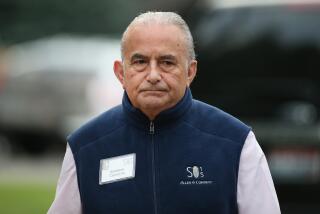Jon B. Lovelace dies at 84; head of American Funds
Jon B. Lovelace, who led the Los Angeles-based American Funds mutual fund company as it became one of the country’s largest money management firms, has died. He was 84.
His family said Lovelace died of natural causes at his home in Santa Barbara on Wednesday.
Lovelace is credited with some of the key innovations that helped set the stage for American Funds’ explosive growth from the 1980s through the mid-2000s, as it became synonymous with successful buy-and-hold stock investing.
The funds’ parent firm, Capital Group Cos., now manages about $1.2 trillion in all, most of that in 33 mutual funds owned by tens of millions of Americans.
Lovelace also nurtured an egalitarian environment at Capital, the polar opposite of the authoritarian regimes of many Wall Street firms.
His daughter, Carey, once referred to him as a “Buddhist businessman” who disdained hierarchy and personal aggrandizement.
Although Lovelace ultimately held the title of chairman of Capital’s fund business until he retired in 2005, “he liked the symbolism of not having titles,” said Paul Haaga Jr., a Capital executive who joined the firm in 1985. “He led quietly, and he led through influence.”
Born Feb. 6, 1927, in Detroit, Lovelace initially was reluctant to join the company that his father, Jonathan, had founded in L.A. as Capital Research and Management Co. in 1931.
The elder Lovelace, a stockbroker, thought equities had become overpriced in the heady days of the late 1920s. In a brilliant move, he sold most of his investments before the 1929 crash.
With his new company, the elder Lovelace began to focus on mutual fund management in the 1930s, as stocks began to recover from the crash. After his son graduated from Princeton University in 1950, the elder Lovelace sought to recruit him to come to Capital.
Jon Lovelace balked at first. He “wanted to make his own way and was concerned about being subordinated to his father, or succeeding simply because his father made it easy,” wrote Charles Ellis in the 2004 book “Capital: The Story of Long-Term Investment Excellence.”
After a brief stint at a consumer finance company, however, Lovelace agreed to join his father, taking a position as a statistician at Capital. His role at the firm quickly began to grow after his father had a heart attack in 1953.
Like his father, Lovelace had an affinity for numbers and trusted in the idea that well-researched stock picking — and a long-term investing view — were the keys to success in the market. He preached against falling for short-term investment fads.
In 1958, Lovelace launched a new approach to fund management: Rather than having a single individual manage a portfolio, Lovelace created a “multiple counselor” system, whereby four or more managers would independently run slices of a fund.
Although it seemed like an invitation to anarchy, Lovelace saw the system as a way to produce investment results that would be “a blend of each manager’s best efforts,” Ellis wrote.
It also fit with Lovelace’s dislike of the traditional Wall Street “star” system. “Because of the nature of our structure, we’re not highly dependent on one person as some organizations are,” Lovelace told The Times in 1990.
The multiple-counselor system produced powerful long-term investment returns on many of American’s stock funds, which in turn made the company a favorite of brokerages eager to sell winning products.
The firm’s assets soared from $146 million in 1955 to $60 billion by 1990, then rocketed to $560 billion by 2000 as individual investors poured into the market.
Lovelace also made the critical decision to spread ownership of privately held Capital away from the family and into the hands of top employees. “He had overwhelming generosity” as the firm’s leader, Haaga said. Capital employs 7,500 people worldwide.
In the community, Lovelace chaired the J. Paul Getty Trust from 1988 to 1993, when the new Getty Center was under construction. He also was a founding trustee and later served as board chairman of the California Institute of the Arts.
An avid hiker, Lovelace helped the Yosemite Fund build and maintain hiking trails including the John Muir Trail.
He is survived by his wife, Lillian; his daughter, Carey; three sons, Jeffrey, Jim and Rob; and six grandchildren.
More to Read
Start your day right
Sign up for Essential California for the L.A. Times biggest news, features and recommendations in your inbox six days a week.
You may occasionally receive promotional content from the Los Angeles Times.






